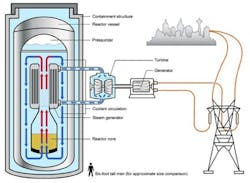Purdue University, Duke partnering to explore potential of Zero-Carbon SMR Nuclear to energize Campus
Purdue University and Duke Energy, already partners in on-site, gas-fired combined heat and power generation, plan to explore together the possibilities of using smaller, advanced nuclear energy to meet long-term needs of the Indiana campus.
Purdue University and Duke Energy intend to explore the feasibility of using advanced nuclear energy to meet the long-term requirements of the campus. The university and Duke Energy will study the efficacy of power produced through Small Modular Reactors (SMRs). SMRs are smaller than traditional nuclear power plants.
These reactors have the potential to meet the current and future energy needs of the university’s West Lafayette campus and excess power to the electric grid.
“No other option holds as much potential to provide reliable, adequate electric power with zero carbon emissions. Innovation and new ideas are at the core of what we do at Purdue, and that includes searching for ways to minimize the use of fossil fuels while still providing carbon-free, reliable, and affordable energy,”
Purdue President Mitch Daniels said. “We see enough promise in these new technologies to undertake an exploration of their practicality, and few places are better positioned to do it.”
Last month, Purdue and Duke Energy celebrated the beginning of operations on the gas-fired combined heat and power (CHP) plant at the West Lafayette, Indiana, campus. The 16-MW CHP facility is owned and operated by Duke, which is selling the electricity and heat to the school.
The facility will be cleaner burning and reduce emissions compared to Purdue’s previous power generation fleet, including the coal and gas-fired Wade Utility Plant which emitted more than 310,000 pounds of carbon dioxide in 2019, according to environmental reporting.
Reactor-generated power does not emit carbon dioxide.
Related stories on Nuclear's Future Role in the Energy Transition
New Frontier Perspective: Are Nuclear-powered Data Centers on the Horizon
Is Micro-Nuclear an option for Net-Zero Microgrids?
Subscribe to EnergyTech's free newsletter for more Insights into the C&I Energy Transition
“Nuclear provides reliable energy and can complement other carbon-free energy sources, such as solar and wind,” Duke Energy Indiana President Stan Pinegar added. “As the largest regulated nuclear plant operator in the nation, we have more than 50 years of experience with safe, reliable operations. We can share that experience with one of America’s premiere engineering schools to see what this technology could do for its campus as well as the state.”
SMRs are modular and can be prefabricated off-site. This saves money and time in construction. The university is developing and verifying the use of a steel-plate composite construction in SMRs at the Bowen Laboratory.
“Steel-plate composite technology is fundamental to successfully deploying SMRs within budget and on schedule,” said Amit Varma, Purdue’s Karl H. Kettelhut professor of Civil Engineering and director of the Bowen Laboratory of Large-Scale CE Research. “We have the world's pre-eminent team and facilities to conduct the testing, analysis, design, and construction demonstration to actualize the potential of this technology.
The joint studies by Purdue and Duke Energy for exploring the use of SMRs will begin in the coming weeks.
-- -- --
(Rod Walton, senior editor for EnergyTech, is a 14-year veteran of covering the energy industry both as a newspaper and trade journalist. He can be reached at [email protected]).
About the Author
Rod Walton, EnergyTech Managing Editor
Managing Editor
For EnergyTech editorial inquiries, please contact Managing Editor Rod Walton at [email protected].
Rod Walton has spent 17 years covering the energy industry as a newspaper and trade journalist. He formerly was energy writer and business editor at the Tulsa World. Later, he spent six years covering the electricity power sector for Pennwell and Clarion Events. He joined Endeavor and EnergyTech in November 2021.
Walton earned his Bachelors degree in journalism from the University of Oklahoma. His career stops include the Moore American, Bartlesville Examiner-Enterprise, Wagoner Tribune and Tulsa World.
EnergyTech is focused on the mission critical and large-scale energy users and their sustainability and resiliency goals. These include the commercial and industrial sectors, as well as the military, universities, data centers and microgrids. The C&I sectors together account for close to 30 percent of greenhouse gas emissions in the U.S.
He was named Managing Editor for Microgrid Knowledge and EnergyTech starting July 1, 2023
Many large-scale energy users such as Fortune 500 companies, and mission-critical users such as military bases, universities, healthcare facilities, public safety and data centers, shifting their energy priorities to reach net-zero carbon goals within the coming decades. These include plans for renewable energy power purchase agreements, but also on-site resiliency projects such as microgrids, combined heat and power, rooftop solar, energy storage, digitalization and building efficiency upgrades.

